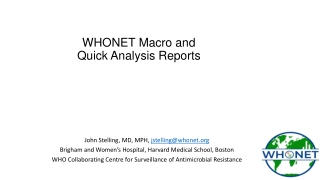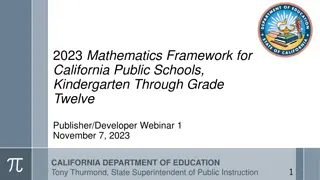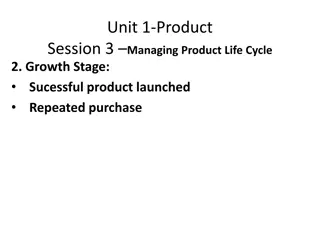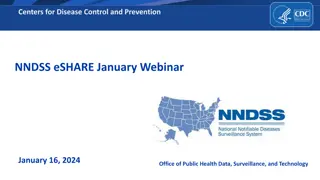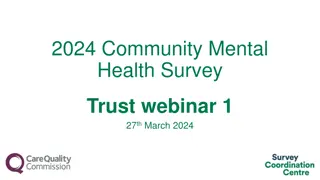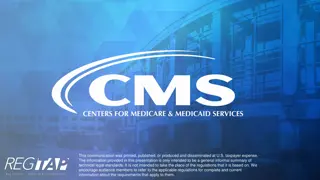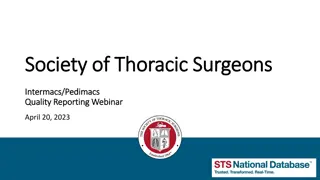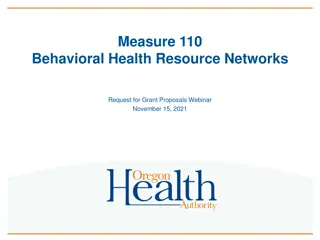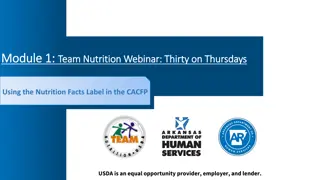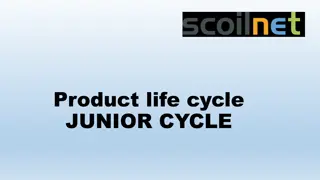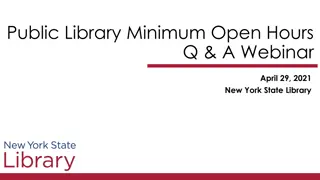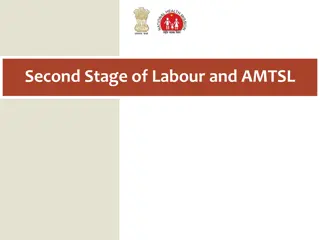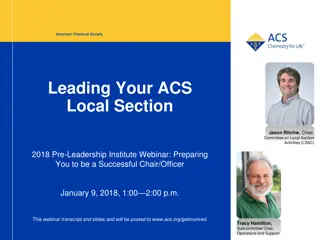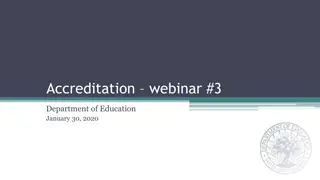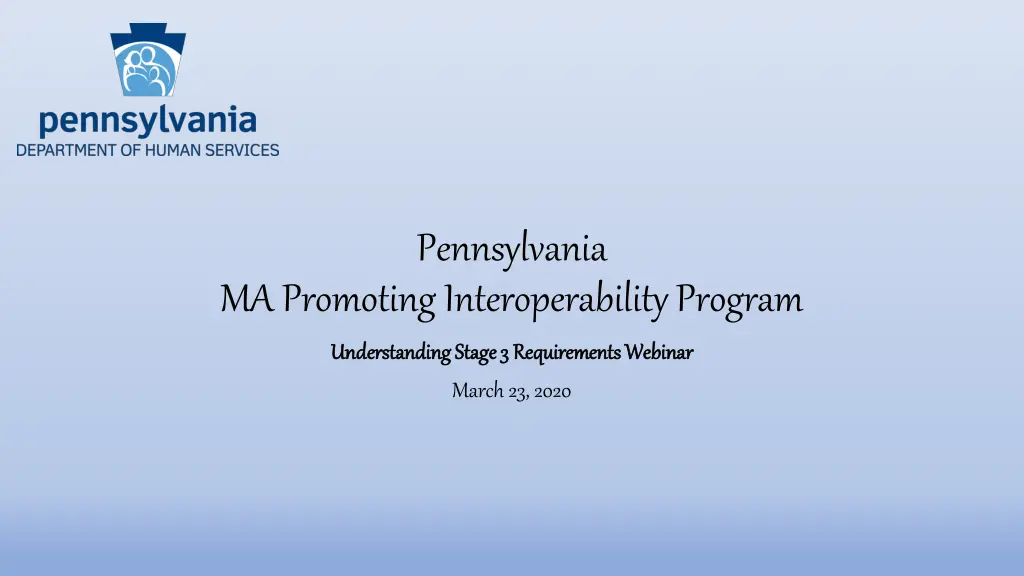
Understanding Pennsylvania MA Promoting Interoperability Program Stage 3
Explore the requirements of Stage 3 in the Pennsylvania MA Promoting Interoperability Program for 2019 and 2020, covering topics like Public Health Reporting, HIE Requirements, and Meaningful Use criteria. Learn about program announcements, certified Electronic Health Record Technology, and reporting periods to ensure compliance with the program.
Download Presentation

Please find below an Image/Link to download the presentation.
The content on the website is provided AS IS for your information and personal use only. It may not be sold, licensed, or shared on other websites without obtaining consent from the author. If you encounter any issues during the download, it is possible that the publisher has removed the file from their server.
You are allowed to download the files provided on this website for personal or commercial use, subject to the condition that they are used lawfully. All files are the property of their respective owners.
The content on the website is provided AS IS for your information and personal use only. It may not be sold, licensed, or shared on other websites without obtaining consent from the author.
E N D
Presentation Transcript
Pennsylvania MA Promoting Interoperability Program Understanding Stage 3 Requirements Webinar Understanding Stage 3 Requirements Webinar March 23, 2020
Disclaimer This webinar was prepared as a service to the public and is not intended to grant rights or obligations. It may contain references or links to statutes , regulations, or other policy materials. The information provided is only intended to be a general summary. It is not intended to take the place of either written law or regulation. We encourage readers to retrieve the specific statutes, regulations, and other interpretive materials or full and accurate statement of their contents. 2
Topics Program Announcements 2019 and 2020 MA Promoting Interoperability Program Requirements Objective 8 Public Health Reporting Program Year 2019 Objective 5 Exception Understanding Objective 7 HIE Requirements Strategies for Success New Features on MAPIR Q&A Resources Available
Program Announcements Program Year 2019 Grace Period has been EXTENDED to May 31, 2020 MAPIR will OPEN to receive Program Year 2020 attestations on April 1, 2020 NOTE: You will be unable to begin your PY2020 application until your PY2019 has received final determination.
Program Year 2019 and 2020 Requirements Certified Electronic Health Record Technology (CEHRT) 2015 Edition CEHRT is required for Program Years 2019 through 2021 (NOTE: if you have upgraded from a 2014 edition to a 2015 edition CEHRT over the past year, you will be required to submit a new signed vendor letter) Meaningful Use All eligible providers (EPs) are required to complete Stage 3 Meaningful Use Program Year 2019 MU specification sheets can be accessed by clicking here Program Year 2020 MU specification sheets can be accessed by clicking here Reporting Periods Meaningful Use reporting period for all EPs is any continuous 90-day period in 2019 and 2020 CQM reporting period is a full calendar year in 2019 for EPs who have attested to MU in previous program years, and any continuous 90-day period in 2019 for EPs that are attesting to MU for the first time. CQM reporting period for PY2020 is any continuous 90-day period in 2020 for ALL EPs. 5
Stage 3 Requirements in 2019 and 2020 Objective 1: EPs must conduct or review a Security Risk Analysis of CEHRT, including addressing encryption/security of data, implement updates as necessary at least once each calendar year. Objective 2: Increased from more than 50% to more than 60% of all permissible prescriptions written by the EP are queried for a drug formulary and transmitted electronically using CEHRT. Objective 3: 5 CDS interventions + implementation of drug-drug and drug allergy checks Objective 4: Medication remains more than 60%- Lab increased from more than 30% to more than 60% Diagnostic Imaging increased from more than 30% to more than 60%. Objective 5: Increased from more than 50% to more than 80%, timeframe to make available changed from 4 business days to within 48 hours. Availability via API also incorporated in this measure. Objective 5 Measure 2: Increased from more than 10% to more than 35%, Patient Education materials must be provided electronically, distribution of paper education materials no longer count towards measure. Requirements that are underlined/bold indicate a difference between Modified Stage 2 and Stage 3 6
Stage 3 Requirements in 2019 and 2020 Objective 6 Measure 1: More than 5% of all unique patients seen by the EP actively engage with the EHR made accessible with Objective 5 requirements either; 1) V,D,T to a third party their health information; or; 2) Access their information through an API that can be used by applications chosen by the patient and configured to the EHRs CEHRT; or; 3) a Combination of both (1) and (2). Objective 6 Measure 2: For more than 5% of all unique patients seen, a secure message was sent using electronic patient function of CEHRT to the patient or (patient-authorized representative) or in response to a secure message sent to the patient. Objective 6 Measure 3: Patient generated health data from a non-clinical setting is incorporated into the CEHRT for more than 5% of all unique patients seen during the reporting period. NOTE: If EP meets the criteria for exclusion for two Objective 6 measures, they must meet the threshold for the one remaining measure. Objective 7 Measure 1: For more than 50% of transition of care and referrals, the EP the transitions or refers their patient to another setting of care or provider of care: 1) Creates a summary of care record using CEHRT; and 2) Electronically exchanges the summary of care record. Objective 7 Measure 2: For more than 40% of transitions or referrals received, and patient encounters in which the EP has never encountered the patient before, they incorporate into the patient s EHR an electronic summary of care document. Objective 7 Measure 3: For more than 80% of transitions or referrals received and patient encounters in which the EP has never encountered the patient before, he/she performs clinical reconciliation. (1) Medication (2) Medication Allergy (3) Current Problem List NOTE: If EP meets the criteria for exclusion for two Objective 7 measures, they must meet the threshold for the one remaining measure. EP must satisfy two measures for this Objective. If EP cannot satisfy at least two measures, they may take exclusions for all measures they cannot meet. 7 Requirements that are underlined/bold indicate difference between Modified Stage 2 and Stage 3
Objective 8: Public Health Reporting For the purposes of meaningful use, public health registries are those administered by, or on behalf of, a local, state, territorial, or national public health agencies; and, clinical data registries are administered by, or on behalf of, other non-public health agency entities. Option 1: Immunization Examples: PhilaVax IIS, Kids First Registry and Statewide Immunization Information System Option 2: Syndromic Surveillance Reporting Currently only available to hospital Emergency Departments Option 3: Electronic Case Reporting Currently unavailable in Pennsylvania Option 4: Public Health Registry TWO PHR can be used Examples: PA Cancer Registry and Prescription Drug Monitoring Program Option 5: Clinical Data Registry TWO CDR can be used Examples: PEDSnet, CDC, ACP Genesis Registry, EPIC Aggregate Data Program If excluding, you will be required by pre-payment team to provide supporting documentation. 8
Prescription Drug Monitoring Program (PDMP) Did you know: Previously, the PDMP required the reporting of Schedule II controlled substances only. The legislature passed a new law, Act 191 of 2014, which requires monitoring Schedule II through Schedule V controlled substances. As per CMS: Public Health Registry Reporting: The EP is in active engagement with a PHA to submit data to public health registries. Submit Data also applies to Submit a Query since the function of the PDMP is for EPs to query medication information, not submit actual data to the registry. For the purpose of the MA PIP, in order to utilize PDMP as a actively engaged PH registry, you must be meaningful submitting queries to the PDMP utilizing CEHRT. If you are interested in integrating the PDMP into your CEHRT, please visit: Department of Health PDMP Integration (How to Apply, Eligibility, Cost ect) FAQ Q: The EP is registered with the PDMP but doesn t prescribe controlled substances, so she did not perform a query during the reporting period. Would the EP s registration in the PDMP be good enough to meet the measure, or does she need actual examples of use to meet the measure?A: 1) PDMP must be integrated into the EHR, PDMP registration does not meet the requirement of utilizing CEHRT to query the PDMP. If the EP did not diagnose or directly treat any disease or condition associated with a public health registry in their jurisdiction during the EHR reporting period, he/she would qualify for Exclusion. Q: If a provider did not prescribe a Schedule II drug during the 90-day reporting period (or calendar year), can the provider claim an exclusion? A: 1) Is PDMP integrated into CEHRT? 2) As seen above monitoring includes Schedule II through Schedule V controlled substances. If during the normal course of his/her practice, an EP does the action that results in data for the registry, and is in active engagement with the registry, but simply does not have any cases for the reporting period, the EP is not required to take an exclusion, and may attest to meeting the measure. 9
Pennsylvania Cancer Registry Did you know: As of 2019, all EPs must use EHRs that are certified to the ONC 2015 Edition cancer reporting standards in order to use cancer reporting as one of their public health measures for incentive payments. Successful ongoing submission of cancer case information from a certified electronic health record technology (CEHRT) to a public health central cancer registry for the entire EHR reporting period is required. Key outpatient and ambulatory specialty areas for electronic cancer reporting include dermatology, urology, gastroenterology, hematology, medical oncology, radiation oncology, and ambulatory surgery centers. FAQ Q: Outpatient Cancer Registry only accepts data from Hematology, Oncology, Urology, Gastroenterology, and Dermatology. While we are in Production, we do not have any Medicaid providers in those specialties, however, we do treat cancer patients. Please advise how our scenario applies when attesting to MU. A: Since you are in production, but do not have any Medicaid providers who are the indicated specialists above, you can take the Exclusion for that provider if he/she does not diagnosis or treat any disease or associated condition. 10
Program Year 2019 Attestation Exception Objective 5: Patient Electronic Access to Health Information The second part of Measure 1 states: The provider ensures the patient s health information is available to the patient (or patient-authorized representative) to access using any application of their choice that is configured to meet the technical specifications of the Application Programming Interface (API) in the providers CEHRT. CMS is allowing flexibility for this part of the measure for PY 2019 ONLY. The following exceptions/requirements apply: Under this CMS concession: API no longer needed to be enabled before or during the reporting period, but rather enabled during CY2019. Requirement to make PHI available via API within 48 hours is waived. NOTE: 48hr requirement still applied to VDT. Q: Did you meet the 80% Threshold for Objective 5 M1? If yes, submit Dashboard to prove threshold met. If no, determine if your EHR Dashboard tracked API access, conduct the following test: 1) Obtain API enable date 2) Review Dashboard for any 90-day period that is entirely prior to API enable date. If test results in a numerator equal to 0, the EHR tracked both VDT and API. If test results in a numerator other than 0, the EHR tracked only VDT. 11
Program Year 2019 Attestation Exception Objective 5: Patient Electronic Access to Health Information Supporting Documentation Requirements Scenario 1: If Dashboard indicates you met the 80% threshold requirement, no further documentation is required. Scenario 2: For EPs that enabled API during or after their MU reporting period, but Dashboard shows they did NOT exceed the 80% threshold. If the Dashboard tracked API access, this created a gap period between the start of the reporting period and the API enabled date, where your Dashboard neither tracked VDT nor API. If this is the case, we require the following: Documentation that shows API enable date occurred during or after your MU Reporting Period. De-identified log/report of all unique patients seen during the reporting period that includes Date of Service and Date VDT access was provided. 12
Understanding Objective 7 HIE Requirements MAPIR will require you to chose your Exclusions FIRST: If no exclusions apply: You will be required to attest to all three measures, and must meet threshold for at least two measures. Exclusion 1: If you qualify for this exclusion, you will be excluded from Measure 1, and will be required to attest to and meet the threshold for both Measure 2 and Measure 3. Exclusion 2: If you qualify for this exclusion, you will be excluded from Measure 2 and 3, and will be required to attest and meet the threshold for Measure 1. If you qualify for both Exclusion 1 & Exclusion 2, you will meet all three measures. NOTE: Exclusion 3 does not apply to the Commonwealth of PA. 13
Understanding Objective 7 HIE Measure 2 For more than 40% of transitions or referrals received and patient encounters in which the EP has never before encountered the patient, he/she incorporates into EHR and electronic summary of care document. CMS Clarification: ALL inbound transitions must be included in the denominator, which includes new patient visits, and return visits after seeing specialists, hospitals, ED, or any other setting of care. Exception: Lab visits. What if the Summary of Care document is unavailable? 14
Strategies for Success Tip 1: Develop a timeline- Decide NOW what 90-day period you are going to use for your 2020 attestation. Tip 2: Determine your eligible providers using our MAPIR Dashboard NEW Provider Report Tip 3: If you are unsure if you meet requirements or exclusions, email us your EHR Dashboard PRIOR to submitting your application. We will review and provide feedback. Tip 4: Upload all required MU supporting documentation at the time of attestation. This will expedite the processing of your incentive payment. We want you to succeed! Email us at RA-mahealthit@pa.gov to ask questions or to set up a call to discuss program requirements. 15
Did you know? Stage 3 has some objectives that have actions that can occur before, during or after the MU reporting period of 90 days, but within the calendar year of the program year; and the patient involved in the action was also seen at least once during the 90-day reporting period. (therefore counted in the denominator) The following Objectives for Stage 3 are included in this option: Objective 5: Patient Access to Health Information- Measure 2 Only Objective 6: Coordination of Care Through Patient Engagement- Measures 1 and 2 Objective 7: Health Information Exchange- Measure 1 Only We suggest: Validate your EHR vendor s report logic for each impacted Objective listed above to ensure action outside a given reporting period will increase the numerator. 16
How to count actions outside the EHR reporting period: Objective 7 Measure 1 Example EHR Reporting Period: 3/1/2019 through 5/29/2019 March 15: Patient A Office Visit April 15: Patient B Office Visit May 15: Patient C Office Visit May 30: Electronically transmits summary of care for Patient A June 15: Patient D Office Visit August 1: Electronically transmits summary of care for Patient B January 3(2020): Electronically transmits summary of care for Patient C April 1, 2020: Attests to PY2019 Numerator: 2 (Patients A & B) Denominator: 3 (Patients A,B,C) Note: If this pertains to you, we will require documentation to support all patients included in your numerator were seen at least once during your EHR reporting period. (therefore are in your denominator) 17
New Features in MAPIR Beginning with PY2019 A Provider On-Demand Resource allows provider groups to track current program status for all their current providers 1 An Instructional Patient Volume Click here link provides clarification between the two patient volume reporting options 2 Screenshots demonstrating each of these new features are found in subsequent slides The Meaningful Use Navigation Panel allows users to complete their MU Objectives in any order and shows them their progress within the section 3 Public Health Drop Down Boxes have been added for each public health option so EPs can select the appropriate registry instead of manually typing in the name 4 The CQM Selection Screen is now split into three sections: Outcome CQMs, High Priority CQMs and All Other CQMs 5 The Required Prepayment Documentation Screen includes information on the documentation the Department requires in order to process the MAPIR application 6 18
Provider On-Demand Resource To access this new resource, log into PROMISe using any EP Medicaid Provider ID and Location ID who is actively linked to your Payee TIN in both PROMISe and the CMS R&A. Once logged in, then click on the Link to MAPIR hyperlink that is located to the left. You will be directed to the EP s MAPIR dashboard. The new provider on-demand resource allows provider groups to track current program status for all their current providers. The new report displays a list of providers actively registered at the CMS Registration & Attestation site (R&A) under a given Payee taxpayer ID number (TIN). Each provider s most recent program participation information is displayed. The report can also be exported into a CSV file for easy data use. 19
Provider On-Demand Resource Once at the dashboard page, click on the hyperlink for the Payee TIN. The Payee TIN report will appear on your screen that includes the list of EPs currently registered under your Payee TIN at the CMS R&A. 20
Provider On-Demand Resource The report includes each provider s name, NPI and most recent Medicaid Promoting Interoperability Program (PIP) participation information. This information can be helpful in determining each provider s eligibility for the current Program Year. The Report may be exported into Excel on the bottom of the page, allowing you to sort as needed. 21
Instructional Patient Volume Link The new Click HERE link is located at the top of the Patient Volume 90 Day Period (Part 2 of 3) screen. Just click on the hyperlink to access the information. Click here The instructional patient volume link provides additional clarification between the two different patient volume reporting period options. 22
Meaningful Use Navigation Panel The Meaningful Use Navigation Panel is identical in nature to the CQM Navigation Panel that has been available since 2017. The navigation panel identifies objectives that are complete. NOTE: The white checkmark indicates the objective is completed but does not mean you passed or failed the objective. The Meaningful Use Navigation Panel allows users to complete their MU Objectives in any order and shows them their progress within the section 23
Public Health Drop Down Boxes MAPIR now incorporates the most common public health registries in a drop down box for each public health option. The pre-populated drop down box will provide a consistent approach for reporting active engagement to the various public health options. In addition to the most common registries, EPs also have the option to report to other registries that are not included in the list. If your registry is not included in the drop down list, you can still select Other and type in the name of the registry in the text field. Immunization Registry Example: The Public Health Drop Down boxes provide standardized registry names for the most common registries for each public health option. It is a more user friendly feature, so EPs do not have to manually type in the registry name. 24
CQM Selection Screen To comply with CMS requirement, the CQM selection screen now has three distinct categories of CQMs. If possible, EPs must select a minimum of one Outcome CQM. If no Outcome CQM applies to the EP s scope of practice, then the provider must select at least one High Priority CQM. If no Outcome or High Priority CQM pertains to the scope of practice, then the EP must attest to at least six CQMs from the list of Other CQMs. The CQM selection screen has been modified to classify the CQMs into three categories: Outcome, High Priority and All Other. EPs are still required to select a minimum of six CQMs, but CMS requires providers to attest to at least one Outcome measure. If no Outcome measure is applicable to the provider s scope of practice, then the EP must choose at least one High Priority measure. Check this box if no Outcome CQMs apply to your scope of practice 25
CQM Selection Screen Check this box if no Outcome or High Priority CQMs apply to your scope of practice 26
Required Prepayment Documentation Screen The Required Prepayment Documentation screen replaces the Application Submission screen from previous program years. Providers can still upload their supporting documentation, but this new screen provides more details about documentation requirements. The Required Prepayment Documentation screen includes details regarding supporting documentation requirements. In addition to uploading documents here, providers can also identify the type of supporting document. At the bottom of the screen, providers will check the acknowledgement statement to indicate they are aware of application processing delays that will occur in the absence of all required documentation. Optional selection of the type of documentation being uploaded Must check here to acknowledge you have read and understand the information regarding supporting documentation requirements 27
Q&A 28
Resources Available EMAIL: RA-mahealthit@pa.gov NEW Website Links: MAPIR Resources Eligible Professional Provider Manual UPDATED May 2019 Meaningful Use Required Supporting Documentation (PY2019-PY2021) 29

